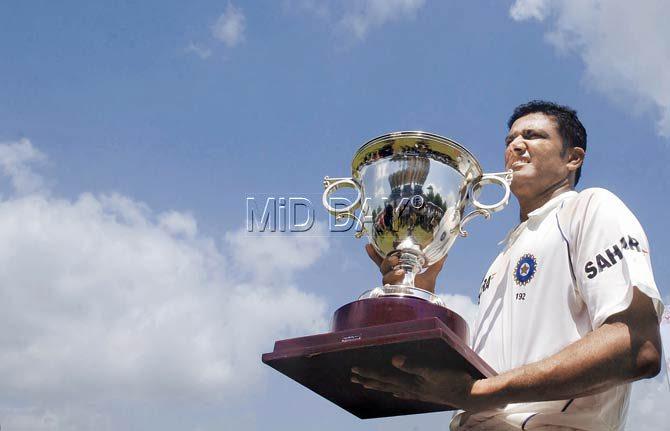It’s no more the most important match in India’s domestic calendar, but the 56-yr-old Irani Cup’s legacy should never be underestimated

 Trivia question: How many Irani Cup matches has Mahendra Singh Dhoni played in his career? Just one. And how many did Sunil Gavaskar figure in? Twelve.
Trivia question: How many Irani Cup matches has Mahendra Singh Dhoni played in his career? Just one. And how many did Sunil Gavaskar figure in? Twelve.
ADVERTISEMENT
In an era, not very long ago, the Irani Cup tie, named after former BCCI president ZR Irani, that pits the Ranji Trophy champions against the Rest of India, was ‘the’ game to either get into national reckoning or add credibility to one’s cricketing reputation.
 Rest of India captain Anil Kumble lifts the Irani Cup after beating Delhi in September 2008 at the IPCL ground in Baroda, Gujarat. Pic/Atul Kamble
Rest of India captain Anil Kumble lifts the Irani Cup after beating Delhi in September 2008 at the IPCL ground in Baroda, Gujarat. Pic/Atul Kamble
The significance of this annual game has reduced alarmingly through a combination of some warped programming over the years and a packed international calendar. Defenders of this occurrence will say that times have changed and the Indian Premier League is the best stage for rookies to play in the company of top players.
Yet another Irani Cup will be played — at the Brabourne Stadium on Sunday — another one sans India’s top players. In a season where a lot of emphasis is laid on Twenty20 cricket — what with the ICC World T20 close at hand — this may be understandable. But it won’t hurt Indian cricket if future Irani Cup fixtures are made star-studded affairs whether or not they are held at the start of the season like in earlier years.
The last truly star-studded and highly competitive Irani Cup game was the one that Virender Sehwag’s Delhi and Anil Kumble’s Rest of India played at Baroda in September, 2008. The Rest had 10 Test players in their playing XI, while Delhi had five and the game ended with Kumble’s men winning by 187 runs.
Batting feats in the Irani Cup have been well documented, none more than Dilip Vengsarkar’s innings at Nagpur in 1975, when Sunil Gavaskar’s Bombay clashed with Bishan Singh Bedi’s Rest of India. Vengsarkar took on Bedi and Erapalli Prasanna to craft a domestic epic of 110 in only 113 minutes with 11 fours and seven sixes. A few days later, Vengsarkar was playing an unofficial Test against Sri Lanka at Hyderabad. Describing the game for Sportsweek’s Cricket Quarterly, sports writer Ron Hendricks wrote: “Vengsarkar, a hard-hitting right hander, used the rapier rather than the bludgeon to bruise and batter Bedi and Prasanna.” Had Eknath Solkar not been on the injured list, Vengsarkar wouldn’t have been picked in the XI, but as the headline to Hendricks’ piece roared, ‘A new star is born.’
Sachin Tendulkar is another among several players to be picked for India after an Irani Cup performance. His was a century effort for Rest of India against Delhi in Mumbai, just before the 1989 tour of Pakistan.
In the Rest’s second innings, Tendulkar was 11 runs shy of a century when the Rest of India’s ninth wicket fell. Venkatapathy Raju was dismissed with the scoreboard reading 209 and many believed that the innings would end there because Gursharan Singh had fractured his right hand and was unable to bat.
Raj Singh made his way to the dressing room and instructed Gursharan to bat with one hand and help 16-year-old Tendulkar get his century. Gursharan managed to give Tendulkar enough strike for a memorable hundred and the champion batsman never forgot that gesture. Sixteen years later, in 2005, he made it a point to grace Gursharan’s benefit match and batted on a wet, overcast day in Delhi. “I will bat even in pouring rain for you,” Tendulkar is believed to have told Gursharan.
Talking to chief selector Sandeep Patil about his most memorable Irani Cup game, one could sense a tinge of disappointment over the Irani Cup’s loss of sheen. He chose the match he played for Mumbai against the Rest of India in 1985, when Mumbai won on the first innings against then India captain Kapil Dev’s Rest. Patil found satisfaction in his 78 against the Kapil-led attack.
He played in an era when the Duleep Trophy and Irani Cup were considered premier platforms to showcase a player’s skill and temperament. To see the Duleep Trophy not being held this season must have saddened him.
Another batsman, Pravin Amre, who has distinguished himself now as a coach, recalled how an Irani Cup innings propelled him to national reckoning in 1990-91, although the selectors picked him only the following season. “We were playing Ranji champions Bengal in Bangalore and captain Ravi Shastri’s first team meeting with us was in the lounge of the KSCA (Karnataka State Cricket Association) guest house. Ravi told us to go out there and show no mercy to Bengal. The start of the game was delayed due to rain and we lost the toss. Our team was in a spot of bother early on, but Ravi and I put on 327 for the fourth wicket. Both of us got double centuries and he ultimately declared at 737 for seven. There was no way Bengal was going to win after that,” said Amre.
In many ways, the Irani Cup represented the kind of competitive edge, which not only first-class players, but Test players too wanted to display in the heat of battle. Hopefully, Mumbai and Rest of India will do justice to the fixture’s legacy.
mid-day’s group sports editor Clayton Murzello is a purist with an open stance. He tweets @ClaytonMurzello. Send your feedback to mailbag@mid-day.com
 Subscribe today by clicking the link and stay updated with the latest news!" Click here!
Subscribe today by clicking the link and stay updated with the latest news!" Click here!






